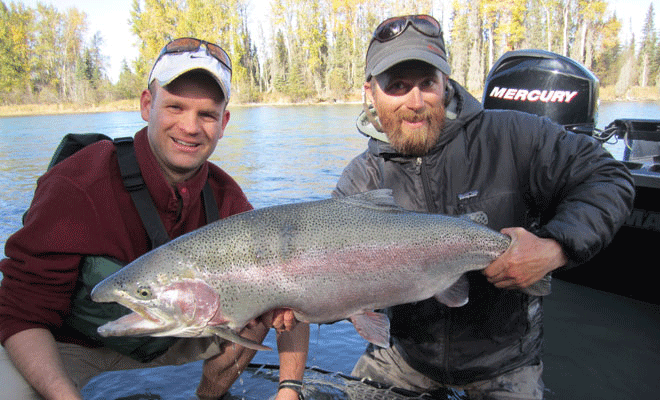
Story & Photos by Jeremy Anderson
Rainbow trout fishing in the fall is probably one of the most exhilarating fishing experiences that one can enjoy when wetting a line, especially on the Kenai River. One day you are throwing a bead the fish can’t resist and then the flesh bite starts to take over. Another day you can only get a bite on a leech you haven’t used since June. There are times when trout want to bite on a dead-drift and times when the swing is the ticket. There are also times when it just doesn’t matter. The more time you spend experimenting with both options the more you will understand when and why a trout bites. The awesome and challenging thing is that there are many reasons why rainbow trout prefer a dead-drift or swing in the fall. It is really the combination of all these factors that determine how you will present your bead or fly to the almighty rainbow trout.
There have been many fall days when it was very obvious what I wanted to throw and how I wanted to present it. Generally speaking, we will throw beads until the egg supply diminishes, then work into the flesh fly, imitating salmon carcus, followed up by swinging leeches or streamers at some point in the late fall. Last season in particular about mid-September when the bead bite should have still been peaking out, it slowed down. Flesh was working okay and had its moments, but it wasn’t the ticket either. What the big trout wanted and how they wanted it was changing.
There was an antsy client in the boat that wanted the big one, and I decided it was time. I threw on a leech on his fly rod, put him at the back of the boat and told him to start swinging. It wasn’t his third cast when the rod almost got ripped out of his hand and a big chrome fish was midair. This beast fought like a big rainbow, bit at the perfect location a trout would be, and I was thinking what a perfect guide switch. It ended up being a 32 x 19.5-inch silver salmon. We caught a few trout that day on leeches but it was obvious, something was changing and the leech would be the next ticket for a bit. Over the next few weeks before things changed again the leech dominated some of the areas we were fishing and we got to be part of it from the beginning of this transition.
While digging into this topic we are going to discuss dead-drifting versus swinging, options with setting up your rod for both, and when you might try switching from a dead-drift to a swing in your presentation.
Dead-Drifting
A dead-drift is a way to present your bead or fly in the water drifting with the current, whether slow or fast water. I like to tell my clients let the river take your indicator like a leaf floating in the water. Let the river dictate where your line goes and walk the dog. Keep your line just tight enough to be able to set the hook but enough loose line to let it drift naturally.
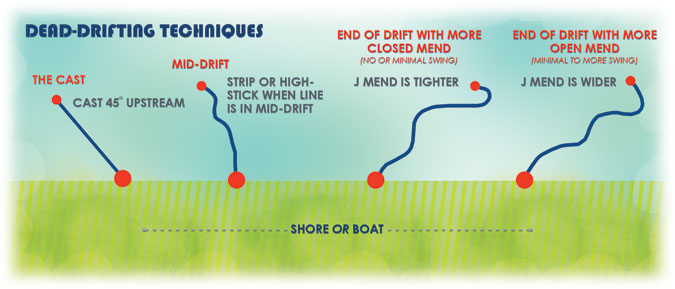
as any drag is a presentation-killer.
On the Kenai River we are usually dead-drifting beads and flesh flies. It is also common to dead-drift a streamer, leech or nymph as well, and sometimes that is what rainbows want.
With a dead-drift, cast upstream at a 45-degree angle from the shore or boat. Keep your rod ahead of the fly or indicator and move the rod with the line in the water. As the line comes back toward you either strip a small amount of linein or lift your rod to “high stick.” This will keep the line tight enough to set the hook if you get a bite in mid-drift. When the line goes past you and starts to head downstream then you are going to have to put a downstream mend in the line and follow your fly or bead to the end of the drift. This mend makes your fly line look like a J in the water. The water speed, depth and what the fish want dictate how open or closed the mend is. If the mend is more closed then you will have an almost completely dead-drift from start to finish. If the mend is more open then there will be a very small swing at the end of the dead-drift.
Swinging
When you swing your bead or fly, the location of your cast combines with water speed to give an accelerated movement of your presentation in the water, faster than the current you are fishing. Swinging a fly is super easy to do and often you are having more success catching fish than trying to learn how to dead-drift. I tell people to cast straight out and keep your rod down.
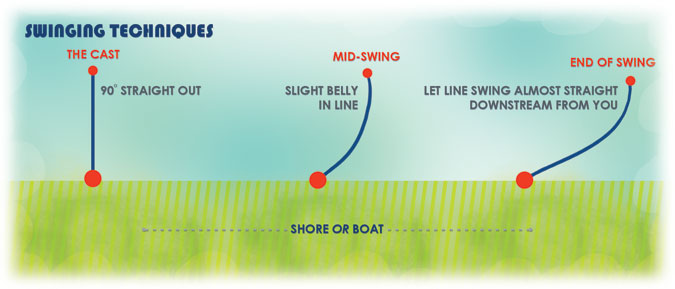
It is most common to swing a streamer, smolt pattern or leech. These flies want more action to fish properly. On occasion a full or partial swing of a flesh fly or bead will work as well, and most often you pick-up on this when you get lazy dead-drifting your bead or fly.
To swing your fly properly you are going to want to cast 90 degrees from the shore or boat straight out in front of you. Immediately get your rod tip down to the water line and lead the line slightly in the water. You may have to lift the line once and roll it slightly upstream to get the right lay in the water. You can tell by looking at your line in the water and you are going to want a slight bow in the water, not a super-tight-line mid-drift. This is going to help set your fly up to be in the right water column and prepare for the right amount of swing. When your presentation nears the end of your cast is when you want the line tighter so you can feel it really swing at the end.
Bottom line: Each casting situation is dictated by water speed and depth. Change your swing to get the desired swing speed. Try different swing speeds in the same spot as well to narrow down what is going to be best for the situation.
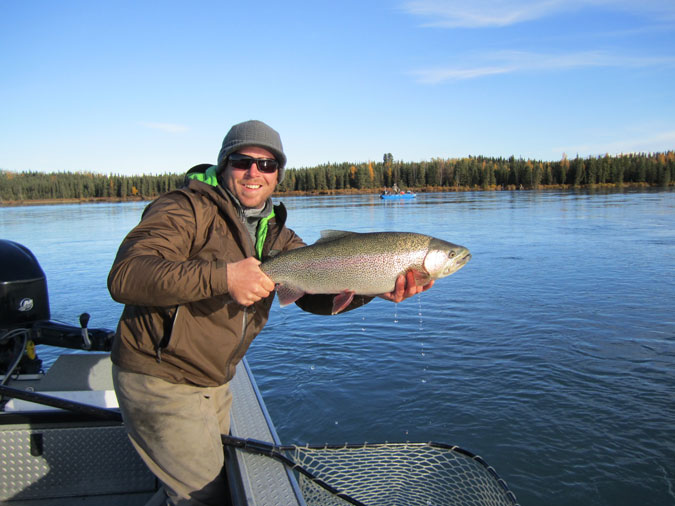
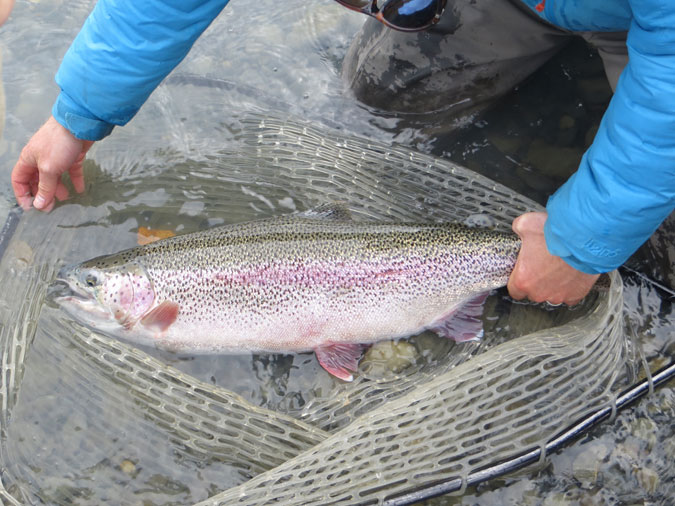 Top: Nick Ohlrich with a late-fall rainbow taken dead-drifting a bead. Bottom: A nice trout caught while swinging a leech during late season. © Alaska Drift Away Fishing
Top: Nick Ohlrich with a late-fall rainbow taken dead-drifting a bead. Bottom: A nice trout caught while swinging a leech during late season. © Alaska Drift Away Fishing
The Setups
When setting up your rod you have more than a few choices to consider. There are pros and cons to each option but here are a few things that help put trout in the net for our crew of trout bums.
Length of leader is important. Usually my rule of thumb is 20% longer than the depth of the river you are fishing no matter if you are dead-drifting or swinging. This is if you are using a floating line specifically. If you are using a sinking-tip fly line then you can go shorter on the leader. I will say a pro of using a floating line is that it will allow you to switch from indicator dead-drifting to swinging very quickly without having to retie every time.
In terms ofindicators, you can swing or dead-drift, with or without an indicator. Most times when dead-drifting we have indicators where the fly line meets the fluorocarbon leader. The indicator helps detect bites better and aids you in providing a decent dead-drift. If you are swinging a fly in slow water sometimes the indicator helps move the fly or bead more. I know it sounds weird to swing a fly with an indicator but it helps you see where your line is and sometimes the trout want it more. There are times with swinging a fly that it matters whether you have an indicator or not so just keep in mind that there are options and if something isn’t working and then switch it up.
The amount of weight that the split-shot, bead and fly has mixed with the water depth and speed is a crucial aspect to consider. I will start with what the weight of my bead or fly is and then use the split-shot to assist in getting the presentation to the desired water-column level. Does the fly have dumbbell eyes or weighted wrap? Is the bead a 6mm or 12 mm? What is the water level, current speed and depth? Whether your intentions are dead-drifting or swinging you have to take the weight of your entire setup and see how that works with the water you are fishing to get the desired results.
When to Switch from Dead-drifting to the Swing
There are those days when you can catch fish just by having your line in the water. The rainbow trout eat it on the dead-drift, the swing, even when you have a sandwich in one hand and a beer in the other, with your rod tucked away in your arm pit or between your legs. We call that Disneyland fishing and it is hard to beat. But most days you have to work to obtain a desired result and only one or two techniques are working. When I am on the water there are a lot of possible things to consider while trying deciding what I want to throw and how I want to throw it.
Do the fish need something to entice them right now or should I be a little more subtle about it? Last fall there was a specific time of day when the leech-bite swing was on like Donkey Kong and then it would shut off. The rest of the day you could only catch trout on a flesh fly or bead dead-drifting through the holes. Matching the hatch in terms of what to throw when is a game we play daily with rainbow trout. When you have it dialed-in the results can be amazing on even the slowest of days.
What location I am fishing in the river right now plays a part, as does the available food supply. Also to consider: Are you fishing a faster run where the food funnels into or are you fishing a long run or deep, slow hole? Are you fishing directly at the food source or downstream where all the food is eventually going? If there is too much or not enough food coming through an area it can change how you want to present your fly or bead. Water levels are critical in deciding where to fish and what to use. Using a combination of swing and dead-drift in different water conditions to keep presentation accurate with what rainbow trout want will increase your success rate.
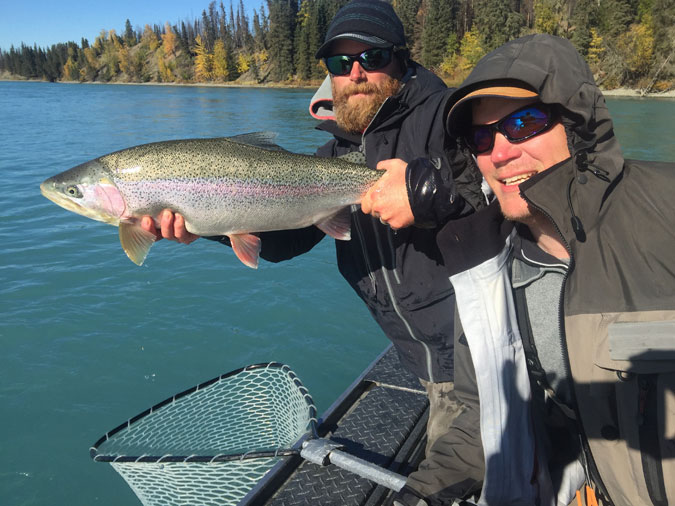 Mr. Daines & Jeremy Anderson with a fall ‘bow that took a large leech on the swing.
Mr. Daines & Jeremy Anderson with a fall ‘bow that took a large leech on the swing.© Alaska Drift Away Fishing
Wrapping It Up
An understanding of the dead-drift versus the swing is important for an angler to have in his or her bag of tricks. You must have the ability to be very intentional with your desired swing or dead-drift depending on conditions. You also have the opportunity to combine a dead-drift with a swing at the bottom of the drift. More often than not it is the style of presentation you are using with your bead or fly that is more critical than having the exact color or size of offering. Try to switch up the speed of your drift or swing slightly before swapping out to another fly or bead and you may be happy with the results. However, the most important part when talking about any fishing-related topic is being willing to try new things and get out of the rut of going through the motions you are so used to.
Jeremy Anderson is a Kenai River rainbow trout guide and co-owner with Nick Ohlrich & Nigel Fox of Alaska Drift Away Fishing. This is their 12th season in business together and these boys are in their prime. You can find more about fall trout fishing at www.guidekenairiver.com.
This article originally appeared in the August/September 2016 issue of Fish Alaska.
